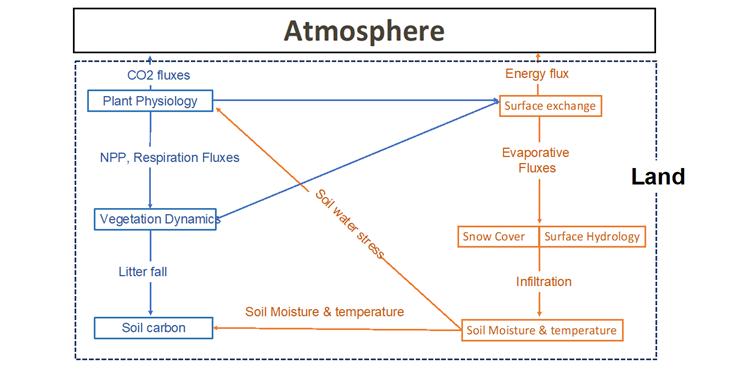Overview
A number of SPECIAL group members work within the LEMONTREE project which aims to build a new model of the terrestrial biosphere. LEMONTREE is now moving into it’s implementation phase. One land surface model (LSM) that the group is currently exploring implementing our research into is the Joint UK Land Environment Simulator (JULES).
JULES is model of the energy balance of the Earth and it’s hydrology. You can see in the diagram below, a demonstration of the interactions between the various components of the model.

Figure 1: Explanatory diagram of how JULES models land-atmosphere interactions. Source: Wenyao Gan.
On the 4-5th of September the JULES annual meeting was held at the UK Centre for Ecology and Hydrology (UKCEH) in Wallingford. The meeting was an opportunity for JULES users to provide updates on recent work within JULES as well as to discuss developments within the model.
One of our PhD students within SPECIAL, Wenyao Gan, attended the JULES meeting virtually. Wenyao is currently developing a JULES photosynthesis scheme, adding in the P-model and thermal acclimation as options to improve upon the JULES model. She is supervised by SPECIAL group leader Sandy Harrison as well as Martin Best from the MET Office.
Following two days of interesting discussion surrounding key developments within JULES, the community has left the meeting excited about upcoming developments within the LSM.
Following the meeting we asked Wenyao for her thoughts regarding key outcomes and areas of interest for the SPECIAL group.
What were the key developments within JULES you think we should be excited about?
“I was surprised to find out that they [the JULES community] were putting a lot of effort into incorporating fire within the model. Also, the talk about peat fires indicates that the JULES community is aware of the importance of accounting for peat.
Further, the community is making an effort to improve their soil water simulation but there is a lot of uncertainty about the right way to develop this.”
A number of SPECIAL group members work on fire-vegetation interactions so it is exciting to hear that there are constant developments occurring within JULES-INFERNO. Additionally, the soil moisture scheme is also a key priority for the LEMONTREE project following their annual meeting. It seems this is something that needs urgent development within the modelling community.
How will these developments in JULES impact your work/research?
“The talk regarding leaf temperature fits in with the discussion we had at the LEMONTREE annual meeting. The P-model is currently using air temperature [to predict GPP] but it is important to accurately simulate leaf temperature due to its impact on GPP. The talk about the use of sapwood flux data also provides an additional dataset we can use to verify transpiration simulation. Prior to this we didn’t have many measurements of transpiration to validate against so this will be useful to LEMONTREE moving forward.”
The P-model is at the core of the LEMONTREE project and their philosophy. Being able to accurately test and validate the P-model and its associated developments is crucial.
What was your highlight from the annual meeting?
“I really enjoyed the talk about evaluation from Siyuan Tian. Although the tests were mainly performed for Australia, it is exciting to see that the evaluation work has been done properly and with great detail.”
We are glad that Wenyao was able to get so much out of the JULES annual meeting this year and are looking forward to hearing about her own developments in JULES as she progresses through her PhD.
